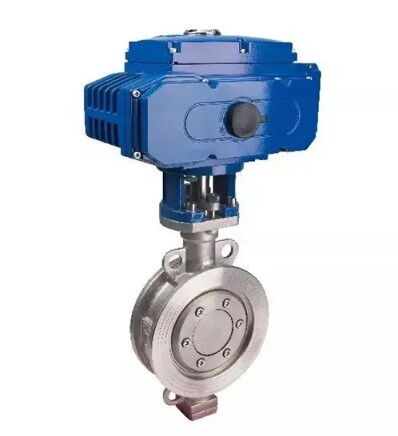Explore Sealing of Electric Stainless Steel Butterfly Control Valve
On this page
Electric stainless steel butterfly control valves serve as a pivotal component in modern industrial control systems, distinguished by their superior sealing performance and extensive application range across various working conditions. Whether in high-temperature, high-pressure, or corrosive environments, these valves provide reliable sealing and stable operation. This article delves into the sealing performance of electric stainless steel butterfly control valves, including their working principles, various sealing methods, and the advantages and installation highlights in practical applications.
The sealing performance of electric stainless steel butterfly control valves depends on their design and operating state, mainly encompassing the sealing principles under two conditions: forward flow and reverse flow.
In the forward flow state, the direction of fluid flow is consistent with the rotation direction of the disc. The sealing performance is primarily determined by two factors.
Torque of the actuator: Drives the valve disc to make contact with the valve seat, forming an initial seal. The greater the torque, the stronger the sealing pressure.
Fluid pressure: As the fluid pressure increases, the contact pressure between the sloping conical surface of the valve disc and the sealing surface of the valve seat also increases. The higher the fluid pressure, the better the sealing effect, as the sealing surfaces between the valve disc and seat are pressed more tightly together.
This design ensures that even under high-pressure conditions, the sealing performance remains stable during forward flow.
In the reverse flow state, where the direction of fluid flow is opposite to the rotation direction of the disc, the sealing effect relies on:
Torque of the actuator: Presses the valve disc towards the seat to maintain the seal.
Reverse fluid pressure: As the reverse fluid pressure increases, the unit pressure between the valve disc and seat may be lower than the fluid pressure. At this time, the spring in the adjusting ring stores deformation energy, maintaining the sealing effect through automatic compensation.
This automatic compensation feature ensures that the valve maintains effective sealing during reverse flow, adapting to changes in fluid pressure.
There are various sealing methods for electric stainless steel butterfly control valves, suitable for different application requirements. The main sealing methods are as follows.
When the valve is closed, the valve disc squeezes the seat, and the elastic element of the seat or disc generates sealing pressure. This method provides sealing force through the deformation of the elastic element, suitable for occasions with high requirements for sealing pressure.
The sealing pressure is generated by the external torque applied to the valve shaft. This method can achieve sealing by adjusting the torque, suitable for applications that require precise control.
The sealing pressure is generated by the elastic sealing elements on the seat or disc through pressurization. This method achieves sealing through the pressurized elastic elements inside, suitable for high-pressure environments.
The sealing pressure is automatically generated by the fluid pressure. When the fluid pressure is sufficient, effective sealing can be achieved without external force or additional devices, suitable for applications with a large range of fluid pressure changes.
Electric stainless steel butterfly control valves, driven by an electric motor, allow the valve disc to rotate freely within a 90° range to control the opening or adjust the fluid flow. The sealing performance has the following characteristics.
High sealing performance: Equipped with a three-offset metal hard seal design, electric stainless steel butterfly control valves perform excellently in high-temperature and high-pressure environments. The valve body and seat are integrated components, and the sealing surface of the seat is made of heat and corrosion-resistant alloy materials, greatly enhancing the sealing performance.
High-temperature resistance and corrosion resistance: Compared to traditional butterfly control valves, electric stainless steel butterfly control valves are characterized by high-temperature resistance and easy operation, making them particularly suitable for high-temperature and corrosive media.
Service life: The sealing performance is compensated as the actuator torque increases, making the valve's sealing effect more stable and extending its service life.
To ensure the optimal performance of electric stainless steel butterfly control valves, the following points should be noted during installation and construction.
Should comply with design requirements to ensure the valve operates normally under designed conditions. The installation location of the valve needs to be reasonably arranged for easy maintenance and operation.
The direction of fluid flow should be consistent with the arrow direction marked on the valve body to avoid installation errors. This is an important factor to ensure smooth fluid flow and sealing performance.
The connection parts of the valve should be firmly and tightly connected to prevent leakage and ensure system stability. When connecting, attention should be paid to using appropriate sealing materials and fasteners.
Through a detailed analysis of the sealing performance of electric stainless steel butterfly control valves, we can see their outstanding advantages in high-temperature, high-pressure, and corrosive environments. These valves not only provide various sealing methods to adapt to different operating conditions but also consider automatic compensation mechanisms in their design to ensure efficient sealing under various fluid pressures. Correct installation and maintenance are key to ensuring their optimal performance. Understanding these factors will help to fully leverage the potential of electric stainless steel butterfly control valves in practical applications, achieving more efficient and safe fluid control.

